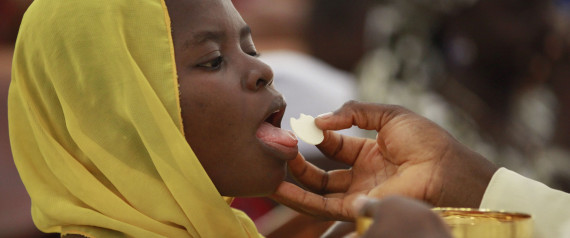Santarem Miracle of the Eucharist
Either in 1225 or 1247, or somewhere in between, there was a woman living in Santarem, who was very unhappy.
She was convinced that her husband did not love her, and was unfaithful to her. She tried all the wiles known to women from the days of Eve, but to no avail.
As a desperate last attempt, she went to a sorceress. The sorceress promised the wife that her husband would return to his loving ways, if the wife would bring her a Consecrated Host.
This presented great fear to the woman.
She knew it was Sacrilege.
She was also convinced that the sorceress was up to no good. The wife didn’t know what to do. She finally gave in.
She went to Mass at the Church of St. Steven, and received Communion, but she did not consume the Host.
Instead, she left the Church immediately, and took the Host out of her mouth, putting it into a kerchief. She then headed for the Sorceress.
Along the way, the Host began to bleed inside the kerchief.
The wife was not aware of it until passersby brought it to her attention, thinking she was bleeding. Panic struck the heart of the woman.
She went home, and put the kerchief and the Host in the bottom of a trunk. She waited all day and night in fear.
When her husband came home late that night, she was sitting in the dark. They went to bed.
We doubt whether she slept very much. The guilt of her sin plagued her. She also didn’t know if the Host had continued to bleed.
Sometime during the night, they were awakened by bright rays of light coming from the trunk, which lit up the entire room.The wife confessed her sin to her husband.
The two of them spent the rest of the night on their knees in adoration before the Miraculous Host the Santarem Miracle.
The next day, people came to the house, attracted by the light. They witnessed the miracle for themselves.
The Parish priest was told. He came to the house, and heard the story from the woman. He brought the Host back to the Church in solemn procession. Encasing It in a wax container, he placed the Host into the tabernacle.
Another Santarem miracle occurred.
The next time the priest opened the tabernacle door, the wax container had broken into thousands of pieces.
In its place was a crystal container, with the blood of the Host inside.
It has been kept in that church until today.
The Church has been renamed, “THE CHURCH OF THE MIRACLE." The little house where the Santarem miracle occurred was on Via delle Stuoie, in Santarem.
From the time of the miracle until now, every year, on the Second Sunday of April, the incident is re-enacted by local actors. The actual Eucharistic Miracle is processed from the house, which was converted into a Chapel in 1684, to the Church.
The Santarem Miracle of the Eucharist only left the city one time, during the invasion of Portugal by Napoleon’s troops in 1810.
The people of the town were afraid of desecration at the hands of the French, and so it was taken out of the city.
It wound up in the hands of the Bishop of Lisbon, who put It on display for the faithful of Lisbon to venerate. It seemed as if he were going to keep Our Dear Lord Jesus in the church of Pacao permanently.
The citizens of Santarem were outraged, and put up a mass protest. It is possible that the Lord did not want the people of Santarem to take his presence in their midst for granted for even a minute.
The Eucharistic Miracle was sent back to Santarem in great secrecy, to prevent the people of Lisbon from knowing It was leaving their city.
The people of Lisbon were not aware that the Physical Presence of their Savior was gone from their city until the day It was restored to Santarem, on December 2, 1811.
The Santarem Miracle is not normally exposed.
However, pilgrim groups with their own priest can usually behold and venerate the Sacred Blood. The Blood is still in liquid form, these 750 years after the Miracle occurred.
We ask ourselves why the Lord does the things He does? Why was there a miracle in Santarem?
Why has it lasted all these years?
Why does the Lord form clusters the way we’ve described? In order to come up with an answer that is acceptable to us, we have to bring God down to our level. That’s the only way we can understand Him. The same question might be asked, “Why does God continue to love us when we are so unfaithful to Him?”
The only answer I can think of is God, to remain God, must love us, because God is Love. God remains faithful because God is faithful.
The sad part of the relationship is that although He must continue to love us, we don’t have to love Him.
We can turn our back on Him, but He is always there, waiting, arms outstretched, just as when He was on the cross.
When we sin, WE BREAK RELATIONSHP WITH HIM. HE REMAINS UNCHANGED. When we go to Confession, and are reconciled with Him, the change comes about in us, not in Him.
He loves us as intensely as he did before we sinned. Thank God He does.



1 comment:
"When you have received Him, stir up your heart to do Him homage; speak to Him about your spiritual life, gazing upon Him in your soul where He is present for your happiness; welcome Him as warmly as possible, and behave outwardly in such a way that your actions may give proof to all of His Presence. - St. Francis de Sales
Post a Comment